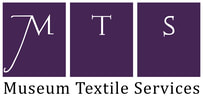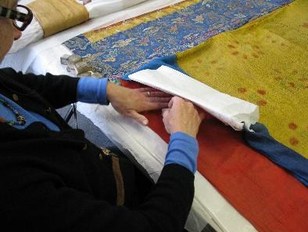|
Andover, Mass. – Museum Textile Services will turn over the last of 18 Tibetan thangkas to the Mead Art Museum at Amherst College next month. The thangkas – cloth paintings depicting Buddhist deities and symbols, sewn into fine silk textiles – were the focus of a two-year conservation project. Picturing Enlightenment: Thangkas in the Mead Art Museum at Amherst College will open August 26, 2011. This will be the first time the thangkas have been seen by the public since 1953. To protect these fragile objects from the potentially damaging effects of light, the collection will be displayed in two parts. The first group of 10 thangkas will be on view from August 26, 2011 to January 1, 2012. To accommodate the careful exchange of the works, the exhibit will close briefly and the remaining eight thangkas will be displayed from January 20 to June 3, 2012. Camille Breeze, Director of Museum Textile Services was thrilled to work with the staff at the Mead Art Museum. “In April 2009 Collections Manager Stephen Fisher called us to survey the collection of thangkas. As a part of that process, we examined each piece, took extensive photographs and recorded measurements, construction details and current condition. The thangkas had been in archival storage for several years and were extremely fragile. When Elizabeth Barker, Director and Chief Curator, discovered the thangka collection, she really wanted to make them accessible – first through an exhibition and then later for study.” A few months later, the thangkas made their way to Museum Textile Services, where they were gently cleaned, the painted surfaces stabilized and the silk supports reinforced. “We cleaned the thangkas with a gentle hand vacuum and vulcanized rubber sponges that absorb and remove a lot of the dirt and grime that accumulates over time. The thangkas were covered in an oily residue, which is probably from the traditional yak butter lamps used in Tibetan culture,” said Camille. “We took a lot of time reinforcing the silk supports to ensure that the thangkas would not be damaged when they are exhibited this fall.” This August, the last of the thangkas will be returned to the Mead Art Museum. "We have really enjoyed learning about the thangkas and Tibetan Buddhism," said Camille. "From a conservation perspective, this project had a lot of exciting challenges. Thangkas consist of two distinct components - the painting and the textile boarder - that are conserved in two very different ways. It allowed our team to draw upon all of our skills as conservators." About Tibetan Thangkas Thangkas function as objects of Buddhist meditation. They are also used as teaching aids and serve as a visual recording of history. Each thangka has a central painting surrounded by a fabric mount, usually made of Chinese silk. This fabric can become damaged over time from rolling, moisture, light exposure and the weight of the hanging thangka. Many thangkas have a silk veil that hangs over the image and can be raised and held in place by a silk cord for viewing. The images depict Buddha, bodhisattvas, other deities or eminent monks. The deliberately conservative artistic styles and iconographic forms used by painters of thangkas have changed little over the course of this thousand-year tradition. During the painting process, the artist performs specific rights. At its completion, a consecration ceremony called the "opening of the eyes" ensures that the resulting image is an accurate reflection of the deity depicted. Most of the thangkas in the Mead's collection were commissioned for a single monastery in Lhasa, Tibet. Religious leaders specified the paintings' subjects and the completed thangkas were displayed in groups, sometimes numbering more than one hundred in a single room. About the Mead Art Museum
The Mead Art Museum houses the art collection of Amherst College, totaling more than 16,000 works. An accredited member of the American Association of Museums, the Mead participates in Museums10, a regional cultural collaboration. During the academic term, the museum is open Tuesday through Thursday and Sunday from 9 a.m. to midnight and from 9 a.m. to 5 p.m. Friday and Saturday. For more information, including a complete schedule of events, all free and open to the public, please visit the museum’s website. About Museum Textile Services Museum Textile Services, the premier textile conservation studio in New England, specializes in the preservation of fabric-based materials for cultural institutions and individuals. Museum Textile Services documents, cleans, stabilizes and mounts historic textiles. Through educational programs and outreach initiatives, Museum Textile Services teaches individuals and cultural heritage institutions how to ensure better preservation of their textiles. Accompanying Image A high resolution copy of the image included above can be downloaded here.
33 Comments
7/11/2013 09:44:24 pm
I am really happy to read this post, I was just I agree with you. This post is truly inspirational. I like your post and all you share with us is up to date and quite informative.
Reply
11/20/2013 06:20:27 pm
I always agree with your articles. We always seem to have the same opinion on things. Hope you keep thinking like me
Reply
7/12/2013 10:19:16 pm
I have been seeking information on this topic for the past few hours and found your post to be well written and has solid information
Reply
9/28/2014 05:00:41 am
Howdy! This is kind of off topic but I need some help from an established blog.
Reply
2/13/2015 01:56:26 pm
I am definitely enjoying your website. You definitely have some great insight and great stories.
Reply
4/18/2015 06:05:27 pm
This blog is providing beautiful news about about the Liberian Educational Sector. It is nice to know about it this is useful information. And such blogs makes us familiar with the whole world.
Reply
stan
2/14/2018 12:48:37 am
Hello everyone, was interesting to read your article. Usually i'm reading <a href="https://www.nytimes.com"> New York Times </a>, but now i will read you too! (https://www.nytimes.com)
Reply
2/28/2023 02:46:41 am
Conservation of 18th Century Tibetan Thangkas is a complex process that requires specialized knowledge and skills in art conservation. Thangkas are religious paintings on cloth or paper that are used as aids for meditation and ritual practices in Tibetan Buddhism. But should note that this specific museum exhibition is quite interesting and probably it is a great topic to discuss among art students.
Reply
4/7/2023 12:54:03 pm
The site offers a wide range of services, including resume writing, cover letter writing, and LinkedIn profile optimization. I appreciate that they have a team of experienced writers who specialize in nursing and healthcare, which ensures that they have a deep understanding of the industry and what employers are looking for.
Reply
8/10/2023 10:32:54 am
In any case, first impressions are very important, and marketing is no exception. That is why the good appearance of your advertising product is a guarantee of the sympathy of a potential client. I use stock photos, mafalda images to create just such amazing projects. The resource contains a lot of useful information, interesting ideas and convenient navigation.
Reply
3/4/2024 04:45:26 am
Hey I know this is off topic but I was wondering if you knew of any widgets I could add to my blog that automatically tweet my newest twitter updates. I've been looking for a plug-in like this for quite some time and was hoping maybe you would have some experience with something like this. Please let me know if you run into anything. I truly enjoy reading your blog and I look forward to your new updates
Reply
3/7/2024 02:40:04 am
Hey, what a dazzling post I have actually come throughout and also believed me I have actually been browsing out for this similar type of blog post for past a week and also rarely encountered this. Thanks quite and I will seek even more posts from you
Reply
Those that cut the wages of their employees remained in the minority at 5.2 per cent, said the Manpower Ministry. Among them, the magnitude of wage cuts was also smaller in 2022 than the preceding year. <a href="https://totohill.com" target="_blank" rel="noopener noreferrer">사설토토사이트</a>
Reply
Leave a Reply. |
Press Contact
Camille Breeze Categories
All
Subscribe to RSS Feed
|


 RSS Feed
RSS Feed